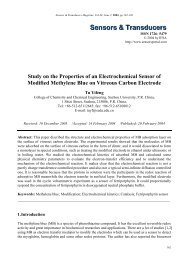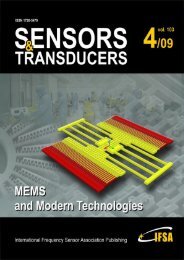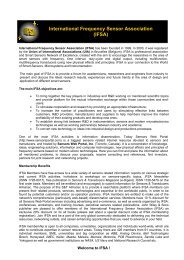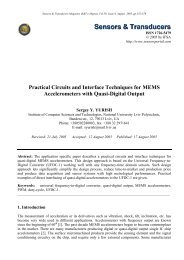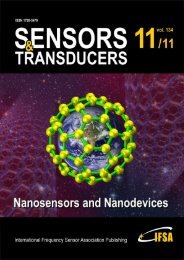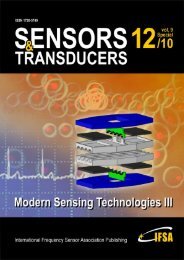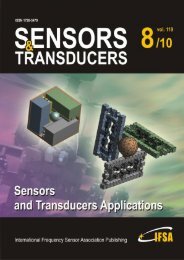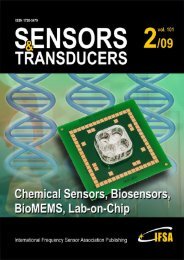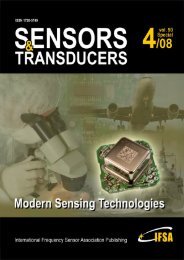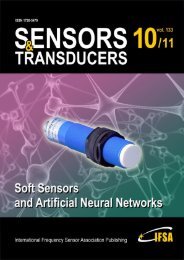Porous Silicon Hydrogen Sensor at Room Temperature
Porous Silicon Hydrogen Sensor at Room Temperature
Porous Silicon Hydrogen Sensor at Room Temperature
Create successful ePaper yourself
Turn your PDF publications into a flip-book with our unique Google optimized e-Paper software.
<strong>Sensor</strong>s & Transducers Journal, Vol. 103, Issue 4, April 2009, pp. 102-108<strong>Porous</strong> silicon (PS), obtained conventionally by anodis<strong>at</strong>ion of crystalline p-type silicon, is a potentialpl<strong>at</strong>form for high efficiency gas sensors mainly due to its very large surface to volume r<strong>at</strong>io, whichenhances adsorption of the sensing gas, a primary step for gas sensor [5-6]. Also the high chemicalreactivity of PS with the environment and the possibility of porosity control by the vari<strong>at</strong>ion of theform<strong>at</strong>ion parameters further cre<strong>at</strong>e an interest in sensing applic<strong>at</strong>ions. Additionally, it is easy tofabric<strong>at</strong>e sensors using PS with comp<strong>at</strong>ibility to silicon IC technology. Despite all the aboveadvantages, problems such as stability, reversibility, and selectivity requires investig<strong>at</strong>ion in details forits commercial use. Though some of these problems have been addressed before [7, 8], thestabiliz<strong>at</strong>ion of PS and minimiz<strong>at</strong>ion of electrical drift in the actual device performance are still twomajor barriers against the fabric<strong>at</strong>ion of PS based devices for field applic<strong>at</strong>ions. Several tre<strong>at</strong>ments tostabilize the PS structure have been reported e.g. controlled thermal oxid<strong>at</strong>ion, nitrid<strong>at</strong>ion,halogen<strong>at</strong>ion and polymeriz<strong>at</strong>ion etc. Surface passiv<strong>at</strong>ion by noble metals may also be very useful, asreported in the liter<strong>at</strong>ure [9, 10]. For gas sensor applic<strong>at</strong>ions, the aim of Pd modific<strong>at</strong>ion is two-fold.First of all, to passiv<strong>at</strong>e the surface by noble metals to get long term stability and then to improve theelectrical response in presence of gases due to its c<strong>at</strong>alytic effect, while maintaining the large specificsurface area of PS.Palladium doped PS based hydrogen sensor was first reported by Polishchuk and co-workers [11]using contact potential difference vari<strong>at</strong>ions (CPD). K. Luongo el al [12] reported a room temper<strong>at</strong>ureimpedance H 2 sensor using nano structured Pd doped layer on the nano porous silicon surface.P. K. Sekhar and co workers tried to find out the influence of anodis<strong>at</strong>ion current density and etchingtime during PS form<strong>at</strong>ion on the response time and stability of Pd doped sensors using the sameelectrode configur<strong>at</strong>ion as reported earlier. [13]. In 2006 Rahimi et al. worked on the importantparameters for Pd growth on PS by electroless pl<strong>at</strong>ing and briefly observed the response to hydrogenfor both l<strong>at</strong>eral and sandwich structures using comb like gold electrical contacts [14].In this paper, we specifically focus on the fabric<strong>at</strong>ion of a stabilized porous silicon based hydrogensensor after modifying the PS surface using noble metal ion like Pd by a simple, reliable and a low costchemical method. The response behavior, time of response and recovery, reproducibility and long termstability are reported here.2. ExperimentalThe nanocrystalline PS samples were prepared by the electrochemical etching of p-type Si wafers of(100) orient<strong>at</strong>ion and 2-5 Ω cm resistivity using a mixture of HF and ethanol (7:3) as electrolyte. Theporosity and thickness of the PS layers (55% and 5 µm) were measured gravimetrically using aprecision semi microbalance type, 290-9842/K of PAG OERLIKONAG CH-DIETKON (Switzerland)[15]. After form<strong>at</strong>ion, PS samples were dipped into 10% HF solution for 10 sec to remove the n<strong>at</strong>iveoxide layer and were immedi<strong>at</strong>ely dipped into the weak acidic solutions (0.01 M) of PdCl 2 for 5 sec.Subsequently the samples were rinsed gently by DI w<strong>at</strong>er and dried in air followed by annealing in air<strong>at</strong> 110 0 C for 10 min inside an electric oven. Different set of experiments was carried out to optimizemodific<strong>at</strong>ion time and solution strength. Pd-Ag (26%) c<strong>at</strong>alytic metal electrodes (Ag was alloyed to Pdto prevent deterior<strong>at</strong>ion of Pd surface due to hydride form<strong>at</strong>ion) of the dimension 2 mm x 2 mm andthickness 0.2µm were deposited on the unmodified and modified porous silicon surfaces and on thebottom p-Si surfaces of the samples by e-beam evapor<strong>at</strong>ion using an Al metal mask. Thin copper wireswere connected to these metal electrodes using silver paste for electrical measurements. The sensorstructure was effectively a back-to-back Schottky configur<strong>at</strong>ion.For the sensor study the samples were placed inside a closed corning glass tube with inlet and outletprovisions for gases. The tube was placed coaxially inside a resistively he<strong>at</strong>ed furnace with a 4 cmconstant temper<strong>at</strong>ure zone. High purity hydrogen and nitrogen were used for the experiments. To103


